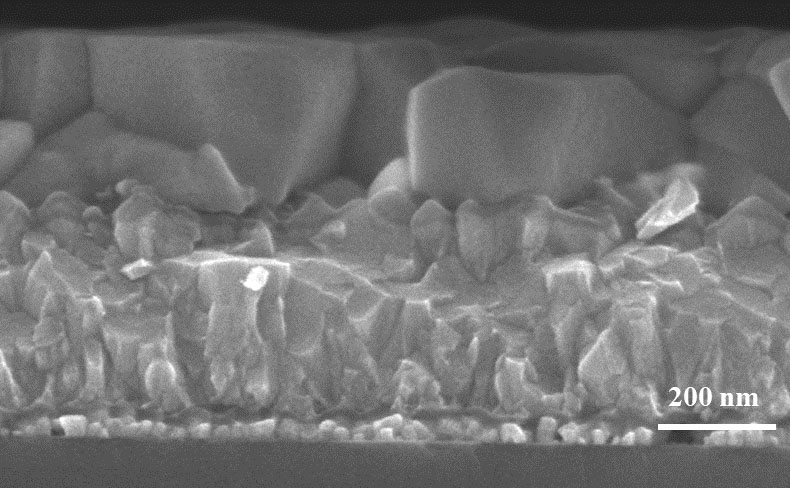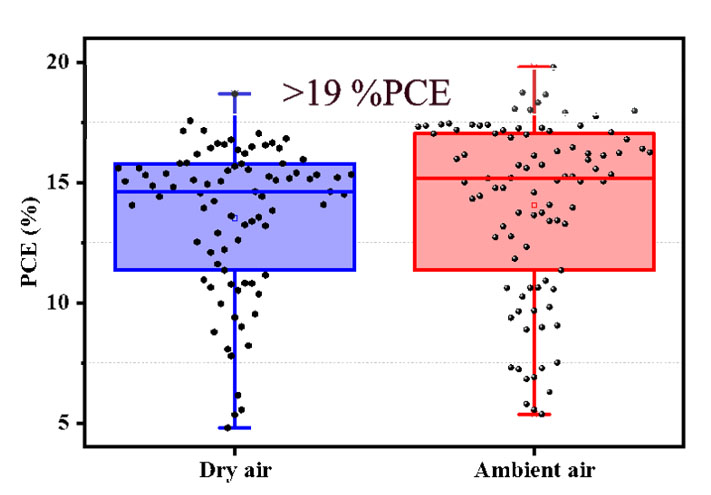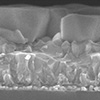| Apr 17, 2024 |
|
(Nanowerk News) Inorganic perovskite solar cells made of CsPbI3 are stable over the long term and achieve good efficiencies. A team led by Prof. Antonio Abate has now analysed surfaces and interfaces of CsPbI3 films, produced under different conditions, at BESSY II.
|
|
The research has been published in Journal of the American Chemical Society (“Unveiling the Potential of Ambient Air Annealing for Highly Efficient Inorganic CsPbI3 Perovskite Solar Cells”).
|
|
The results show that annealing in ambient air does not have an adverse effect on the optoelectronic properties of the semiconductor film, but actually results in fewer defects. This could further simplify the mass production of inorganic perovskite solar cells.
|
 |
| Under the scanning electron microscope, the CsPbX3 layer (large blocks in the upper part of the image) on the FTO substrate looks almost exactly the same after annealing in ambient air as after annealing under controlled conditions. (Image: HZB)
|
|
Metal halide perovskites have optoelectronic properties that are ideally suited for photovoltaics and optoelectronics. When they were discovered in 2009, halide perovskites in solar cells achieved an efficiency of 3.9 per cent, which then increased extremely fast. Today, the best perovskite solar cells achieve efficiencies of more than 26 per cent.
|
|
However, the best perovskite semiconductors contain organic cations such as methylammonium, which cannot tolerate high temperatures and humidity, so their long-term stability is still a challenge. However, methylammonium can be replaced by inorganic cations such as Cesium (Cs). Inorganic halide perovskites with the molecular formula CsPbX3 (where X stands for a halide such as chloride, bromide and iodide) remain stable even at temperatures above 300 °C. CsPbI3 has the best optical properties for photovoltaics (band gap ∼1.7 eV).
|
Production in glove boxes
|
Perovskite semiconductors are produced by spin coating or printing from a solution onto a substrate and are typically processed in glove boxes under a controlled atmosphere: There, the solvent is evaporated by heating, after which a thin layer of perovskite crystallizes. This ‘controlled environment’ significantly increases the cost and complexity of production.
…or ambient conditions
|
|
In fact, CsPbI3 layers can also be annealed under ambient conditions without loss or even with an increase in efficiency of up to 19.8 per cent, which is even better than samples annealed under controlled conditions.
|
 |
| The box chart statistics show efficiencies of solar cells that were manufactured under controlled conditions compared to solar cells that were annealed in ambient air. (Image: HZB)
|
What happens at the interfaces?
|
|
“We investigated the interfaces between CsPbI3 and the adjacent material in detail using a range of methods, from scanning electron microscopy to photoluminescence techniques and photoemission spectroscopy at BESSY II,” says Dr. Zafar Iqbal, first author and postdoctoral researcher in Antonio Abate’s team.
|
BESSY II unveils a surface modification
|
|
At BESSY II, the team of Prof. Marcus Bär used hard X-ray photoelectron spectroscopy (HAXPES) to analyse the chemical and electronic structure of the differently annealed CsPbI3 and perovskite/hole transport layer interfaces. “In the samples that were annealed in ambient air, we observed a surface modification that improves the mobility of the charge carriers at the interface,” explains Iqbal. Optical spectroscopy showed that annealing in air resulted in fewer defects.
|
Upscaling might become simpler
|
|
“Our study explains why the annealing of CsPbI3 films in ambient air works well,” says Iqbal. This could be particularly interesting for upscaling processes for potential mass production.
|



